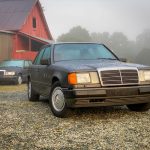Happy Birthday, you beautiful brick. That’s right, folks, the much-loved Volvo 240 is 50 years old this year.
The 240 built on the three-box design first deployed in the 140 of 1966, but when it hit the streets for 1974, the 240 upped the sophistication level a few pegs. The new car had a longer wheelbase, and a MacPherson strut front suspension improved handling, while rack-and-pinion steering replaced the 140’s cam-and-roller type for more precision. Safety, too, was a hallmark of the 240, with stout “Commando” bumpers backed by energy-absorbing crumple zones.


Originally offered with the 140’s B20 two-litre engine, the line of “Redblock” fours would grow in displacement over the years, first to 2.1 then 2.3 litres, with output generally hovering around 110–115bhp. The addition of an intercooler turbo brought the available power figure up to a healthy 162bhp, while a wheezing diesel and, in the 260 series, a V-6 were also offered.
They came as four-door saloons (244), five-door estates (245) and, until 1984, as two-door coupes (242). That 2.8 million of them were produced over 19 years is a testament to their popularity. That so many still remain on the road, often with more than a quarter-million miles, is a testament to their engineering.
To commemorate the anniversary, Volvo has just released a short retrospective video, with the company’s heritage manager Hans Hedberg as our guide. The piece is effectively a sizzle real, if such a thing term can be used in conjunction with such a dull car, and it traces the 240’s genesis in the Volvo Experimental Safey Car to the shadow it still casts over current Volvo cars. “The 240 series blended usefulness with durability and became a symbol of dependability and innovation,” Hedberg says. He’ll get no argument from anyone who has ever driven or ridden in one.









